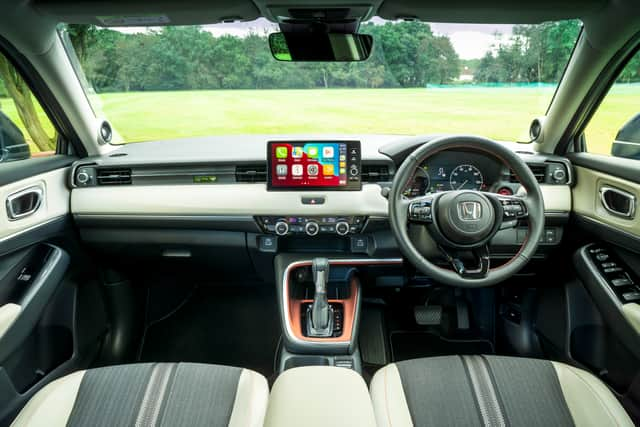2022 Honda HR-V review: Sensible SUV puts passenger space and comfort to the fore


The original Honda HR-V was a bizarre-looking three-door compact SUV marketed as a “joy machine” back in the days where the phrase “compact SUV” hadn’t yet been invented.
Its successor was a far less interesting thing - think shrunken CR-V - and although it was decent enough it hardly screamed “joy”.
Advertisement
Hide AdAdvertisement
Hide AdNow we’re onto the third generation of what we can now confidently call Honda’s B-SUV and some of that original quirkiness is definitely back.
Certainly in appearance the latest HR-V has taken a leap from the instantly forgettable second-generation. In place of its generic droopy front, the new car has an almost toy-like boldness with an upright nose and tightly-packed grille arrangement. At the back, the steeply angled tailgate and some clever use of contrasting trim panels gives the roofline the now-fashionable coupe style without sacrificing too much in the way of headroom.


At first glance, it’s perhaps a little challenging on the eye but after a few days with it I have to admit the looks grew on me and among plenty of bold looking competitors such as the Ford Puma, Vauxhall Mokka and Nissan Juke it’s not out of place.
Honda says that throughout the new HR-V’s development the focus was on creating “a consumer product that must appeal through desirability, functionality and usability”. Describing a car as a “consumer product” is a bit of a comedown from “joy machine” but it’s a fair reflection of what the HR-V is really about.
Advertisement
Hide AdAdvertisement
Hide AdIt’s clear its designers have concentrated on making the HR-V as practical and usable as possible. To that end, it’s the most spacious car in its class and four adults will all fit comfortably, with impressive leg and shoulder room for a relatively compact car. It’s certainly more. The boot is 320 litres which is smaller than the class average but the HR-V features Honda’s famous Magic Seats. These fold down to create up to 1,290 litres of boot space or flip up to create a tall and wide alternative cargo area behind the front seats.
Just as impressive as the HR-V’s space is the look and feel of the interior. It’s not particularly flashy or unique but it’s nicely thought out with simple controls that are easy to find and use, and a built quality that feels like it will last decades. Even the materials feel pretty high-end - not something that’s always been true of Hondas - with a mix of fabric and leather on the seats, doors and dash.


Honda has committed to having an all-electrified mainstream range in 2022 and like the Jazz, Civic and CR-V, the HR-V features the brand’s e:HEV full hybrid arrangement as its only powertrain option.
A 1.5-litre engine and two electric motors send a total of 129bhp to the front wheels via a fixed ratio e:CVT transmission. The details of how the system works are horribly nerdy but, on the road the HR-V will flit between petrol-only, EV-only or a combination depending on the driving conditions and requirements.
Advertisement
Hide AdAdvertisement
Hide AdOfficial figures put the HR-V’s economy at 67.3mpg and CO2 emissions at 96g/km and Honda claims that its system will operate in EV mode more than any rival in urban driving, although we can’t say whether this is the case in the real world.
At the launch of the new Civic, Honda’s engineers talked about how they had worked to improve the hybrid drivetrain from its application in the HR-V. Having driven them back to back, it’s clear to see what they meant. The HR-V still exhibits the weird elastic band response and the tiresome droning associated with CVT gearboxes, despite the fact the E-CVT transmission is of a different design.
That said, it’s a lot better than previous iterations and as long as you’re happy to bimbling along at part throttle rather than wringing its neck, it will move along perfectly nicely. Such treatment suits the HR-V’s character better anyway where a focus on comfort means this is a soft-riding easygoing alternative to the firmer, sportier Puma and Mazda CX-30.
As with other Hondas, the hybrid powertrain and generous size for its class instantly put the HR-V’s price above many regular petrol-powered rivals. It almost fits into a tiny sub-section of SUVs that are somewhere between the Puma/Juke and the Kuga/Qashqai in terms of size and price.
Advertisement
Hide AdAdvertisement
Hide AdThe Toyota C-HR is its most immediate rival in size and powertrain and against that the H-RV is keenly priced, with the range starting at £29,410 and rising to £34,850 for the Advance Style. At that price you get a fairly comprehensive specification including heating, power assistance and automation for anything that needs it plus additional exterior styling touches and a full package of driver assistance features.
The latest H-RV doesn’t inspire joy in the way that its predecessor did but for buyers looking for a frugal and spacious option that sits somewhere between the more established SUV categories it’s well worth considering.


Honda HR-V Advance Style
Price: £34,850; Engine: 1.5-litre, four-cylinder petrol, twin electric motors; Power: 129bhp; Torque: 187lb/ft; Transmission: Single-speed E-CVT; Top speed: 106mph; 0-62mph: 10.7 seconds; Economy: 67.3mpg; CO2 emissions: 96g/km
Comment Guidelines
National World encourages reader discussion on our stories. User feedback, insights and back-and-forth exchanges add a rich layer of context to reporting. Please review our Community Guidelines before commenting.
